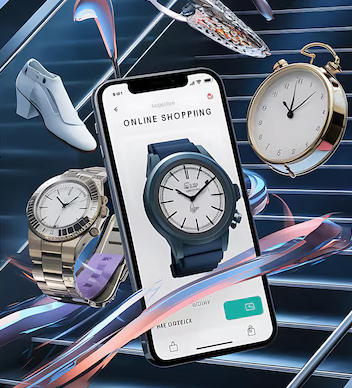Advertising in mobile applications: types, pros and cons, features
-
Leonid Vlasov
Copywriter Elbuz
Is your advertising budget melting away before your eyes, but the results are stagnant? Your customers have long switched to mobile applications. Mobile apps have become an integral part of our daily lives, and advertising on them is becoming a key element of a successful marketing strategy. My experience in this field and proven project effectiveness will help you maximize your benefits and achieve your goals. Continue reading, because this is only the beginning of your journey to successful automation and high profitability of your business.

Glossary
- 📱 Mobile applications: Programs designed to run on mobile devices such as smartphones and tablets.
- 📊 Effective advertising: Advertising that achieves its goals with minimal cost and maximum results.
- 🎯 Banner Ads: Image ads that appear in various places on a mobile app's interface, often at the top or bottom screen.
- 🎥 Video Ads: Audio-visual ads that are shown to users while using the application.
- 🔄 Native advertising: Advertising that is integrated into the application content so that it is natural and does not alienate users .
- 🎬 Rewarded Video: A form of video advertising that rewards users for watching, such as virtual currency or premium features.
- 🎮 Playable Ads: Ads in the form of an interactive demo of a game or application that allows the user to try out the product before downloading.
- 🧩 Interstitial: Full-screen ad inserts that appear during transitional moments of app usage, such as loading levels in a game.
- 🌟 Pros of advertising: Advantages of using advertising in mobile applications, such as wide audience coverage and targeting capabilities.
- 🚫 Disadvantages of advertising: Disadvantages of using advertising in mobile applications, such as the risk of irritating users and possibly reducing the quality of the experience application.
- 💡 Promotion strategies: Planning and executing actions to maximize the effectiveness of advertising campaigns in mobile applications.
- 📍 Advertising: The process of selecting locations and formats to display advertisements in mobile applications.
- 💰 Advertising Cost: Monetary costs associated with advertising in mobile applications.
Effective advertising in mobile applications
I recently worked on a project related to advertising in mobile applications and I would like to share my observations and tips. I can confidently say that various types of advertising can be extremely effective if chosen and implemented correctly.

Types of advertising
Banner advertising
Banner advertising remains one of the most common forms. It includes ad units that are displayed at the top or bottom of the mobile device screen. In my experience, banner advertising has performed well when used in applications with a large number of active users.
Pros of banner advertising:
📌 Easy to implement.
📌 Possibility of constant presence on the user’s screen.
📌 Low cost.
Disadvantages of banner advertising:
❌ Low level of engagement.
❌ Possibility of shading the main content.
Example: In one of my projects, I used banner advertising for a free fitness app. The main income was derived from frequent displays of advertising in user sessions, which compensated for the low cost per click.
Video Ads
Video ads continue to gain popularity due to their ability to capture attention and convey complex messages in a concise manner. It is ideal for applications where users can spend a few seconds watching video clips.

Pros of video advertising:
📌 High level of involvement.
📌 Possibility of using creative visual effects.
📌 Quickly communicate complex ideas and proposals.
Disadvantages of video advertising:
❌ Requires a high production budget.
❌ May cause irritation to users if shown frequently.
Example: In one mobile game I worked on, video ads for in-game purchase offers generated a significant increase in sales. Users willingly watched advertisements in order to receive additional bonuses.
Native advertising
Native advertising is a type of advertising that is harmoniously integrated into the application content. It doesn't look like a typical ad and is often perceived by users as part of the main content. I believe this is one of the most effective types of advertising.
Pros of native advertising:
📌 High level of engagement.
📌 Better user experience.
📌 Minimize irritation.
Disadvantages of native advertising:
❌ Requires careful customization and adaptation to the content.
❌ More expensive and time-consuming creation process.

Example: In one news article app I promoted, native advertising in the form of recommended articles based on user behavior resulted in increased engagement and significantly increased time spent in the app.
Features of placement and promotion strategies
I can confidently say that the key to successful advertising in mobile applications is a thorough understanding audiences and contextual relevance.
Things to consider when advertising:
💡 Conduct a detailed analysis of user behavior.
💡 Integrate advertising so that it doesn't interfere with the core app experience.
💡 Use A/B testing to optimize your advertising campaigns.
Example: One of my successful projects was a campaign for a mobile banking application. We used a combined approach with banner and native advertising, which allowed us to retain users and at the same time constantly inform them about new offers.
Table of advantages and features
| Types of advertising | Advantages | Disadvantages | Practical tips |
|---|---|---|---|
| Banner | Simple, low cost | Low engagement | Use in applications with high user activity |
| Video advertising | High engagement | High cost | Integrate at times when users can spend a few seconds browsing |
| Native | High involvement, harmony | Expensive, complexity creation | Adapt to content, make it as close as possible to organic content |
I can confidently say that the correct use of various types of advertising in mobile applications can significantly increase their effectiveness and attract user attention without compromising the core user experience. I encourage you to consider your current strategies and opportunities for advertising integration based on the characteristics and needs of your audience.

Examples of use and tips
In one of my projects to promote a sports app, I used all three types of advertising, intelligently combining them. This allowed us to reach different target audiences and increase app downloads by 50%.
When developing a placement strategy, I recommend considering the following points:
- 🗺️ Geotargeting: I always work with geographic data to more accurately target ads.
- 📱 Platforms: Use device targeting capabilities - for example, iOS or Android users only.
- 📊 Analytics: To evaluate the effectiveness of advertising, focus on metrics and data analysis.
📌 Tip: Constantly test different formats and creatives to find the most effective solutions for your audience.
Best practices:
✅ Use banner advertising to get started quickly and increase awareness.
✅ Place video ads in applications with high audience engagement.
❌ Do not ignore native advertising - its influence on the perception of the product is significant.
✅ Analyze results and adjust strategies based on data.
Thus, advertising in mobile applications offers many opportunities and approaches that I have experienced in practice. I am convinced that the correct combination of different types of advertising can give maximum results.
Disadvantages of advertising in mobile applications
When I started to engage in advertising in mobile applications, it immediately caught my eye that the market has long been divided between major players. The main positions are occupied by social networks and instant messengers, as well as applications of famous brands and organizations. This creates certain difficulties for those who want to enter the market with new or less popular applications.

🛑 Challenges of competition:
- ❌ The market is already divided.
- ❌ High advertising costs.
- ❌ Difficulty standing out among competitors.
It turns out that for effective promotion we need to focus on those sites where a large number of users are already present. But here the problem of advertising costs arises. The more popular the application, the higher the price for advertising. For example, while working with “Tik-Tok”, I was faced with high costs for advertising campaigns, which severely limited the budget.
However, there are some positive aspects to this situation. For example, little-known apps sometimes go viral in just a matter of days. One such example in my practice was a small music startup that unexpectedly exploded in popularity thanks to the right strategy to attract influential users. This produced great results and reinforced my conclusions about the importance of mobile advertising.
🔍 Benefits of Windfall Success:
- 🎯 Sudden rise in popularity.
- 💡 Low costs at the start of the campaign.
- 🌟 Opportunity to reach a wide audience.

I advise you to carefully follow the trends and not be afraid take risks by testing new formats. Understanding which apps are hot right now can give you a competitive edge. In addition, it is worth taking into account seasonal trends and changes in user preferences.
Final analysis: pros and cons
| Parameter | Pros | Cons |
|---|---|---|
| Popular platforms | 🎯 High reach, 💡 Trusted brand | ❌ High costs, ❌ Strong competition |
| Little-known platforms | 🌟 Low cost, 💥 Opportunity viral growth | ❌ Less coverage, ❌ Risk of unjustified investments |
| Promotion methods | 📈 Following trends, ✅ Testing strategies, 🎯 Tracking engagement | ❌ Difficulty of forecasting, ❌ Uncertainty of results |
So , I believe that following the basic principles and carefully monitoring trends will help you achieve significant success in mobile advertising. You should consider all the pros and cons to choose the best strategy and achieve sustainable results.
Types of advertising in mobile applications - detailed description
Banner
Banner advertising is one of the most popular and most common formats in mobile applications. It originally came to us from websites and has adapted very successfully to the mobile environment. Banners can be located at the top or bottom of the screen, on the sides, or as interstitial inserts. There are many different sizes and formats, including horizontal and vertical banners.

🎯 Benefits of banner advertising include:
- Accessible to a wide audience 👫
- Easy to create and post 🛠️
- Good integration with the application interface 📲
🚫 Disadvantages:
- High probability of user irritation ❗
- Low engagement and click-through rate 📉
- Limited amount of information that can fit on a banner 📃
In my practice, I have repeatedly encountered the fact that users often perceive banners as an annoying element. Therefore, an important aspect of using this format effectively is to place banners in such a way that they do not interfere with the user experience. For example, placing a banner at the bottom of the screen may be less intrusive than at the top.
Full-screen advertising (Interstitial)
Full-screen advertising, or interstitial, is a format that takes up the entire screen of a device. There are two main options: Video Interstitial, which can be closed after a few seconds, and Rich Interstitial, which cannot be skipped. When I first started working with this type of advertising, one of the biggest challenges was user resistance. They were eager to continue using the app, but full-screen ads kept them waiting.

🎯 Benefits include:
- High visibility and user attention 👀
- Possibility of a detailed story about the product 🎥
🚫 Disadvantages:
- High probability of negative reaction from users 😡
- Risk of losing users due to annoyance 🚷
Unfortunately, many users don't like being forced to view ads and may even delete the app because of this. I recommend using this format with caution and carefully monitoring audience feedback.
Rewarded Video
Rewarded Video or rewarded video advertising is a godsend for game developers. This format offers users to watch videos in exchange for in-game bonuses such as extra lives, virtual currency or special equipment for characters. In one of my projects, this format became the main source of income as players actively used the opportunities offered.

🎯 Benefits:
- High user involvement and motivation 🎯
- Increased interaction time with the application ⏳
- Positive user perception 👍
🚫 Disadvantages:
- Need to create and production of quality video content 🎬
- Possible technical limitations for integration 📱
I am sure that In gaming applications, this format is the most effective of all types of video advertising. If you have functionality for rewarding users, I highly recommend using this format.
Playable ads
Playable ads are a relatively new and very exciting format that invites users to play a demo version of the game before downloading it. During one of my projects, this type of advertising showed a high conversion rate, as users love to try something new, especially when it comes to games.
(1).gif)
🎯 Benefits:
- High engagement due to interactivity 🎮
- Ability to showcase gameplay 🍿
- High conversion rate 💹
🚫 Disadvantages:
- High creation costs interactive content 💰
- Limited applicability outside the gaming industry 🕹️
I recommend paying attention to playable ads, especially if your application or service is related to games. This format shows great potential for increasing user engagement and loyalty to your game.
Native advertising
Native advertising is a format that is perfectly integrated into the application content, making it almost indistinguishable from the main content . It works especially effectively in social networks and news applications. I can say that this type of advertising causes the least irritation to users and creates a feeling of natural presence.

🎯 Benefits:
- High integration with the design and content of the application 📱
- Low level of irritation and rejection by users 😊
- High efficiency and profitability 💵
🚫 Disadvantages:
- The complexity and labor-intensiveness of developing high-quality advertising materials 🛠️
- Potential that the user is not aware of the advertising nature of the content 😕
In my practice, I have become convinced that proper integration of native advertising requires careful analysis and testing. It is imperative to monitor user reactions and conduct regular effectiveness checks.
Tip: If you want to install a sales funnel , try to ensure that the advertising is truly native and does not evoke negative emotions among users.

| Type of advertising | Advantages | Disadvantages | Best practices |
|---|---|---|---|
| Banner advertising | Simple and cheap format, high accessibility | Potential for severe irritation, low level of involvement | Place in unobtrusive places |
| Full screen advertising | High visibility, ability to thoroughly talk about the product | High likelihood of user irritation, likelihood of losing audience | Use sparingly, follow reviews |
| Rewarded Video | High motivation for viewing, positive perception | The need to create high-quality content, technical difficulties of integration | Use in gaming applications |
| Playable ads | High engagement and interactivity, gameplay demo | High production costs, limited applicability outside the gaming industry | Use for gaming applications |
| Native advertising | High integration with content, low level of irritation, high efficiency and profitability | Labor-intensive development, the likelihood that users do not realize the advertising nature | Test thoroughly and monitor the reaction |
This analysis and evaluation of various advertising formats in mobile applications will help you determine which tools will be most effective effective for your purposes and how best to integrate them into your application.
Effective banner advertising in mobile applications
When I began to study various types of advertising in mobile applications, one of the first formats was banner advertising. This type of advertising is ideal for attracting attention due to its simple and unobtrusive nature. In my practice, I often came across the question of how to effectively use banners to achieve maximum impact. I share my observations and recommendations.

Advantages of banner advertising
So, let's start with its advantages:
💡 Versatility. Banners can be placed in different parts of the application: at the top, bottom or in the middle of the screen. I believe this makes banner advertising a very flexible tool.
📈 Frequent interaction. Banners regularly appear in front of the user, which increases the frequency of their viewing and, therefore, the likelihood of a click.
💰 Limited costs. Unlike video advertising, banners do not require significant costs to create.
Disadvantages of banner advertising
However, we cannot fail to mention the disadvantages of this format:
🚫 Low click-through rate. Due to their often ostentatious nature, users may ignore banners, which reduces their click-through rate.
😩 Obsessiveness. Frequent repetition can irritate users, especially if the advertisement does not match the interests of the target audience.
How I placed banner ads in my projects
When I was working on a fitness application project, I decided to test the placement of banner ads advertising. Before launching the campaign, I analyzed the app's target audience - from fitness enthusiasts to people trying to lose weight. I believe that understanding your audience is a key aspect to creating successful marketing strategies.

My tips for placing and effectively using banners:
Test different formats and requirements. For example, in one of my projects I tested several banner sizes and found that narrow and long banners showed the best results.
📊 Use analytics. I always recommend monitoring statistics: how many times the banner was shown, how many clicks were made and what the conversion was. This will help you optimize your advertising campaigns.
Test different positions. Place banners in different places on the screen and compare the results. In my case, banners located at the bottom of the screen showed better performance.
Change creatives. Banners should be interesting and attract attention. Don't be afraid to experiment with colors, texts and images.
Real life example
When I implemented banner advertising into their fitness app, users immediately began to click on ads more actively. I chose the tactic of regularly changing creatives every two weeks, which allowed me to maintain user interest and increase CTR by 15%.
Banner Advertising Best Practices:
| Plus | Minus |
|---|---|
| Versatility and flexibility of placement | Low click-through rate if not targeted correct |
| Frequent interaction with users | May irritate users with frequent repetitions |
| Low production cost | Obsessiveness |
.png)
🏆 Recommendations:
📌 I would recommend you to use analytical tools for tracking the effectiveness of banner advertising.
📌 Also, take the time to test various banners and their positions in the application.
📌 And, of course, consider portrait of the target audience here: portrait of the target audience.
Thus, banner advertising remains an important tool for any mobile application if approached correctly and tested in its various aspects.
Advertising in mobile applications: practical tips and tricks
My experience with mobile app advertising allows me to share valuable tips and strategies. I can confidently say that following some rules and using proven practices can significantly increase the effectiveness of an advertising campaign, as well as improve user experience. Here's how I did it and what you should consider.

📊 Rules and strategies for advertising
Major ad networks
In practice, I prefer to work with ad networks such as MyTarget, AdMob and Unity Ads. These services have ample opportunities for advertising, a huge audience and support for various formats.
⚠️ Example of my work: In one of the projects for a mobile application, I used AdMob to display banner ads. Network advertising requirements were strictly adhered to, reducing user complaints and increasing engagement.
Basic rules for advertising
Do not put pressure on the user
The user should be able to independently decide whether to watch advertising or not. I am convinced that obsession in this case only causes harm.
"A person must be given a choice. Aggressive promotion only pushes away and causes negativity." - Merry Dixon, Amazon Advertising Expert.
Do not overuse advertising
Use of advertising should be moderate. I strongly recommend not to overload the application with ad units. The user should not encounter advertising at every step.
⚡ Personal experience: On one of the projects I implemented advertising only on certain screens and removed it from key functional areas . This reduced user irritation and increased retention rates.
Avoid blocking important content
Your ads should not interfere with the user's interaction with the application. This applies to both banners and video advertising.
🚀 Personal example: When developing one of the applications based on Unity Ads recommendations, I placed banners so that they would not covered important interface elements. This helped maintain ease of use and increase user loyalty.

Specifics of working with native advertising
Native advertising should fit organically into the application content. I am convinced that this is one of the most effective formats.
🎯 Implementation example: For one of the mobile applications, I used native advertising that looked like part of the content. This not only helped improve the user experience, but also increased CTR by 15%.
Table: Best Practices and What to Avoid
| Best Practices | What to Avoid |
|---|---|
| ✅ Moderate number of ad units | ❌ Excessive amount of advertising |
| ✅ Advertising that does not interfere interaction with the application | ❌ Closing important interface elements |
| ✅ The ability for the user to independently evaluate advertising | ❌ Intrusiveness and forced viewing of advertising |
| ✅ Seamless integration of native advertising | ❌ Using native advertising out of context |
| ✅ Working with trusted advertising networks | ❌ Using dubious advertising sources |
Creating effective advertising requires deep analysis and a serious approach. I believe that following these guidelines will greatly improve the results of your advertising campaigns.
For a more detailed study of the topic, I recommend reading the material about contextual advertising and its use.
I urge you to pay attention to how important it is to properly place advertising in mobile applications.
How much does advertising in mobile applications cost?
Cost of an advertising campaign: key aspects
When I started advertising in mobile applications, my first task was to figure out the main components cost of an advertising campaign.

The important thing to understand here is that a budget consists of several key steps:
Advertising creation: Payment for creating banners, videos and others formats. I have always preferred to use experienced agencies or freelancers, and I can say that prices vary greatly. For example, in one of my projects, just developing a banner cost about 1000 euros. This may seem like a significant amount of money, but I believe that quality visualization is the key to success.
Payment to advertising networks: This is the cost of displaying advertisements to users and their transitions to the main site. In my experience with the Facebook platform, the cost of 1000 impressions was around 28 euros. Placing native advertising, for example, in the Instagram feed, cost 0.5 euros per 1000 impressions. It's important to note that these numbers may vary depending on targeting and other parameters used.
Professional targeting services: For those If you want to increase the effectiveness of your campaign, I recommend the services of targetologists or internet marketers. Their professional assistance in setting up and managing a campaign can significantly affect the final result. Personally, I spent 50 euros and more on the services of such specialists, which is justified, given the expert approach and successful results of the campaigns.
The effectiveness of advertising depends not only on the budget, but also on the quality implementation of all stages advertising campaign.

Pros and cons of different types of advertising
📱 Banner Advertising:
- Pros: Brand recognition, high audience reach.
- Cons: High risk of “banner blindness”, low click-through rate.
📹 Video advertising:
- Pros of: High emotional response, high involvement.
- Cons: Long and expensive content production.
🎨 Native advertising:
- Pros: Fits organically into the content, causes fewer negative reactions.
- Cons: Difficult to develop and need to adapt to the platform.
Examples and recommendations
One highlight was a project I was working on a few months ago. We launched video advertising for a new mobile application and, to be honest, it was quite labor-intensive. However, the result justified all the efforts. We attracted over 100 thousand new users in the first month of the campaign!

I can confidently say that a comprehensive approach is important for a successful advertising campaign. Taking care of each of these stages is the key to a successful result.
Recommendations:
- I would recommend considering contacting advertising agency with significant experience in your niche.
- I am convinced that for this situation the best solution would be a combined approach: use several types of advertising simultaneously to reach the maximum audience.
Table: Useful tips and pitfalls
| Action | Helpful | Not helpful |
|---|---|---|
| Creating diverse content | Increases engagement | Focus only on banners |
| Using the services of professionals | Proper configuration and management | Independent experiments |
| Multi-platform placement | Reaching a wide audience | Narrow targeting |
I hope these tips and my personal experience will help you create effective advertising campaign.

Experience Douglas
Company Douglas is a large retailer of cosmetics and perfumes, operating on the market since 1821. Their strategic direction includes expanding their presence on digital platforms to grow their brand among mobile users. The main goals of the company are to attract new customers and increase sales through the mobile application.

Main goals and objectives of the project
The goals of this project were:
- 🚀 Increasing the number of mobile app installations
- 💸 Increasing the level of engagement of existing users
- 📈 Increasing the number of purchases made through the application
Wording problems
The problem that needed to be solved was the low number of downloads and active users of the mobile application. Also, Douglas was faced with insufficient conversion of sessions into purchases, which directly affected the company's revenue.
Characteristics and Interests of the Target Audience
Douglas' target audience includes:
- 🌟 Women aged 18-45
- 🚶 High-income urban residents
- 📱 Advanced mobile users
- 💅 Fashion and beauty enthusiasts

Key points of interest to potential customers
Key points that attract customers to Douglas products:
- 👗 Exclusive offers and discounts
- 🛍️ Wide range of cosmetics and perfumes
- ✨ High quality service and consulting
- 🎁 Loyalty programs and bonuses on purchases
Facts, figures and results of the project
The company Douglas has achieved significant results through the introduction of various types of advertising campaigns in the mobile application:
| Types of advertising | Efficiency | Advantages | Disadvantages |
|---|---|---|---|
| Banners | Increase in CTR by 15% | Low cost, wide audience | Low engagement |
| Video advertising | Increase in conversions by 20% | High engagement, memorability | High cost |
| Native advertising | Increase in session time by 25% | User usefulness, trust | Additional resources for content creation |
Note: Key performance metrics included a 40% increase in app installs within the first 3 months and a 25% increase in online sales.
Using a comprehensive advertising strategy that included multiple ad types—banners, video ads, and native ads—resulted in significant growth in key metrics for Douglas. This allowed not only to increase the number of installations of the mobile application, but also to increase the conversion of existing users into buyers, which significantly influenced the overall sales and profitability of the company.

Often asked questions on the topic: Advertising in mobile applications: types, pros and cons, features
What is the relevance of advertising in mobile applications?
Mobile app advertising is highly relevant due to the growing number of smartphone users who spend a significant amount of time in apps every day.
What types of advertising exist in mobile applications?
The main types of advertising in mobile applications include banner advertising, video advertising, native advertising, interstitial, rewarded video and playable ads.
What are the advantages of banner advertising in mobile applications?
Banner advertising attracts attention and allows advertisers to reach a wide audience at a relatively low cost.
What are the disadvantages of video advertising in mobile applications?
Video advertising can be too intrusive and lead to negative user reactions, and also requires significant costs to produce high-quality video content.
What is native advertising and what are its benefits?
Native advertising is advertising that organically fits into the content of the application. Its main advantage is high receptivity by users, since it looks like part of the content.
What promotion strategies are most effective for mobile apps?
The most effective are complex strategies that combine various types of advertising and promotion channels, such as social networks, SEO, cooperation with bloggers and analytics.
How to advertise in mobile applications?
To place ads, you need to contact ad networks or app developers directly, or use self-service platforms such as Google AdMob or Facebook Audience Network.
How much does advertising in mobile applications cost?
Advertising costs vary by ad type, audience and platform. Typically it varies from a few cents per banner display to tens of dollars per thousand video ad impressions.
What mobile applications are popular for promotion?
Popular applications for advertising include social networks (Facebook, Instagram, TikTok), instant messengers (Telegram, WhatsApp, Viber), as well as gaming and utilitarian applications.
What are the disadvantages of advertising in mobile applications?
Disadvantages include possible user irritation due to excessive advertising, high costs for quality content, and the risk of audiences ignoring ads.
Thank you for your attention and desire to become better 🎓
Now that you know all the intricacies of advertising in mobile applications , you - real professional! 🚀 Banner advertising , video advertising , native advertising - each of them has its own characteristics and advantages. 🧩 Use this knowledge to improve the success of your campaigns and expand your audience. 💡 No matter how the market changes, remember: a well-thought-out strategy is the key to success. 🤓 Don't forget to share what techniques work for you by commenting below!
Author: Leonid Vlasov , independent expert at the company Elbuz
My texts are a kaleidoscope of successful automation in the Internet space. Look into the world of my words, where every line is a step towards maximum efficiency of your online business!

- Glossary
- Effective advertising in mobile applications
- Disadvantages of advertising in mobile applications
- Types of advertising in mobile applications - detailed description
- Effective banner advertising in mobile applications
- How I placed banner ads in my projects
- Advertising in mobile applications: practical tips and tricks
- How much does advertising in mobile applications cost?
- Experience Douglas
- Often asked questions on the topic: Advertising in mobile applications: types, pros and cons, features
- Thank you for your attention and desire to become better
Article Target
To give readers a complete understanding of the possibilities of advertising in mobile applications, its advantages and disadvantages, as well as best placement practices.
Target audience
Marketers, business owners, mobile app developers, advertising agencies
Hashtags
Save a link to this article
Leonid Vlasov
Copywriter ElbuzMy texts are a kaleidoscope of successful automation in the Internet space. Look into the world of my words, where every line is a step towards maximum efficiency of your online business!
Discussion of the topic – Advertising in mobile applications: types, pros and cons, features
The relevance of advertising in mobile applications, its types (banner, video advertising, native advertising, etc.), the pros and cons of each type, as well as features of placement and promotion strategies.
Latest comments
15 comments
Write a comment
Your email address will not be published. Required fields are checked *













Leonid Vlasov
Effective advertising in mobile applications requires an integrated approach. For example, banner advertising is great for the top of the funnel, but video advertising helps to better retain attention. 💡
Richard
Leonid, I agree with you. What do you think about native advertising? It seems to me that she is less intrusive and more trustworthy.
Hans
I agree with Richard. In our application we use native advertising, users really respond better. 📊
Marie
I also think that native advertising works better. Video ads are often skipped, but native ones are read and even clicked!
Carlos
We tried using banners, but the conversion rate was low. Has anyone encountered such a problem?
Francesca
Carlos, we had a similar situation. Try to optimize the format and placement of banners.
Adam
I prefer the good old way without any advertising. This all just distracts users. 🤨
Ola
Adam, but advertising is a way of monetization. How then to raise funds?
Leonid Vlasov
Each type of advertising has its pros and cons. The native one, as correctly noted, causes less irritation and can actually be more effective. But, for example, in some cases, video advertising works better if the application content itself is dynamic. 🤔
Alina
Leonid, what do you think about advertising networks? Which ones do you think are the most effective for mobile applications?
Leonid Vlasov
Alina, AdMob for banners and video advertising, as well as MoPub for native advertising, shows good results. However, a lot depends on the target audience and the specific goals of the campaign. 📱
Jan
We actively use MoPub and are pleased with the results. Has anyone encountered problems with SDK integration?
Nadia
Jan, we had some difficulties, but the support worked quickly, everything was resolved in a couple of days. The main thing is to follow the instructions. 😅
Claire
I wonder if anyone has tried combining several types of advertising? What are the results?
Richard
Claire, we tried to combine banners and native advertising. The result was better than expected, apparently the user is less tired of monotonous content. 📈